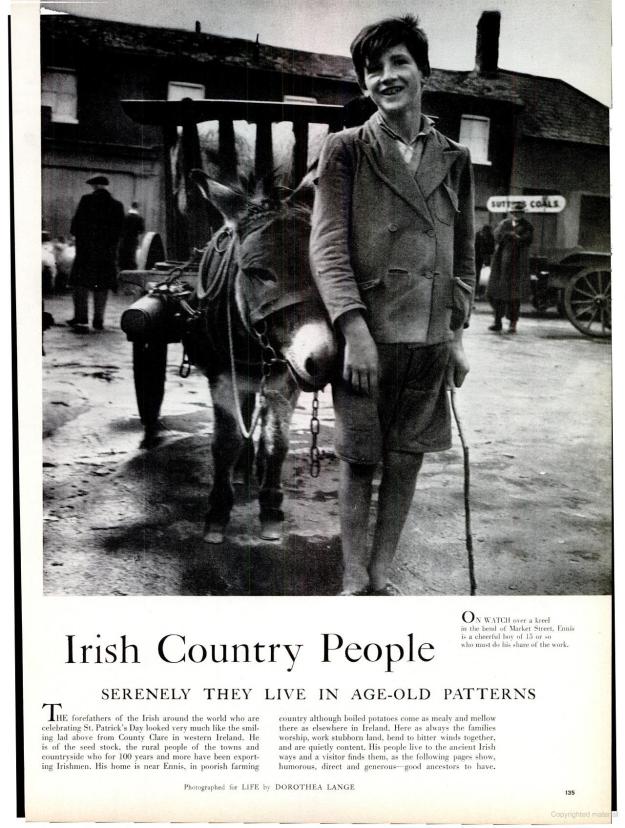Seventy years ago this month American photographer Dorothea Lange arrived in County Clare and pointed her camera toward the locals. Six months later, at St. Patrick’s Day, Life magazine advertised her work as “12 pages of beautiful and sensitive pictures” that put readers “face to face with the rural folk of Ireland.”[1]From advertisement for the March 21, 1955, issue, as featured in the New York Daily News, March 17, 1955. The spread included about two dozen black-and-white images from among Lange’s more than 2,400 negatives.
Then 59, Lange was accompanied by her 29-year-old son, the writer Daniel Dixon, who provided the accompanying text and photo captions. They visited Ennis, Ennistymon, Tubber, Sixmilebridge, and other locations.
“The forefathers of the Irish around the world who are celebrating St. Patrick’s Day looked very much like the smiling lad above,” the feature began. “Here as always the families worship, work stubborn land, bend to bitter winds together, and are quietly content. His people live to the ancient Irish ways, and a visitor finds them, as the following pages show, humorous, direct and generous–good ancestors to have.”
View Lange’s “Irish Country People” photo essay, and the the entire March 21, 1955, issue with Marilyn Monroe on the cover.
Lange conceived and pitched her idea to Life after reading The Irish Countryman by the American anthropologist Conrad M. Arensberg. The 1937 book emerged from his Harvard doctoral dissertation.
“What made it an instant classic … was not Dr. Arensberg’s specific observations on Irish society but the prescriptions he laid down for making and interpreting those observations with scientific precision,” the New York Times reported in his obituary. “The study became a model for other community studies, and a demanding model it was, requiring that researchers study a target culture from the inside, making meticulous notes on everything they saw, heard or experienced.”[2]”Conrad Arensberg, 86, Dies; Hands-On Anthropologist”, New York Times, Feb. 16, 1997.
By coincidence, Paris-based American anthropologist Robert Cresswell arrived in Ireland soon after Lange’s images were published in Life to conduct another analysis of Irish rural life, much like Arensberg. Cresswell’s work in and around Kinvara, County Galway, resulted in the 1969 study, Une Communauté Rurale de l’Irlande.[3]See “Ireland in the 1950s – Through the Lens of Robert Cresswell“, Roaringwater Journal, Feb. 23, 2020. His archive of more than 450 black and white photographs, nearly 100 Kodachrome slides, 16mm film footage, plus documents and notes, are held by the Kinvara Community Association.
Retrospective and revival
Lange is best known for her Depression-era work for the Farm Security Administration. A few months after her death in 1965, six more of her previously unseen Irish images were displayed in a retrospective at the Museum of Modern Art in New York, the first one-person retrospective by a female photographer at MoMA.[4]See “1950s Ireland“, Roaringwater Journal, Feb. 16, 2020.
Four decades after Lange’s visit to Clare, Irish author Gerry Mullins reviewed her negatives at the Oakland Museum of California. He returned to Clare determined to find people she had photographed, as he recalled recently for the Irish Independent.[5]See “Grieving family had no photo of young Mary…” Irish Independent, Sept. 14, 2024. Mullins’ 1996 book, Dorothea Lange’s Ireland, included an essay by Dixon. Photos To Send, a documentary film, followed in 2001.
Ireland has long beguiled photographers, both domestic and foreign; from the late 19th and early 20th century black-and-white images of the Lawrence Studio’s Robert French to the 1913 work of the French women Madeleine Mignon-Alba and Marguerite Mespoulet. The pair produced what are believed to be the first color images of the country.[6]See my post, “Irish history movie ideas: The Colors of Ireland“, June 21, 2020. In 1978, the American photographer Jill Uris joined her author husband, Leon, to produce Ireland: A Terrible Beauty, with more than 300 photos, about a third in color. His best-selling novel Trinity was published the following year. Her follow-up photo book, Ireland Revisited, appeared in 1982.
I welcome details of other photojournalism projects in Ireland, especially by Americans.
References
| ↑1 | From advertisement for the March 21, 1955, issue, as featured in the New York Daily News, March 17, 1955. |
|---|---|
| ↑2 | ”Conrad Arensberg, 86, Dies; Hands-On Anthropologist”, New York Times, Feb. 16, 1997. |
| ↑3 | See “Ireland in the 1950s – Through the Lens of Robert Cresswell“, Roaringwater Journal, Feb. 23, 2020. |
| ↑4 | See “1950s Ireland“, Roaringwater Journal, Feb. 16, 2020. |
| ↑5 | See “Grieving family had no photo of young Mary…” Irish Independent, Sept. 14, 2024. |
| ↑6 | See my post, “Irish history movie ideas: The Colors of Ireland“, June 21, 2020. |




